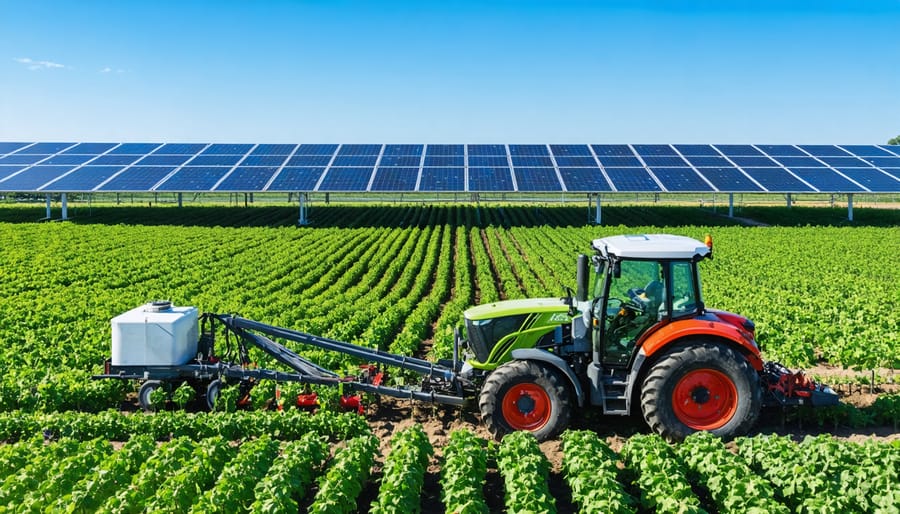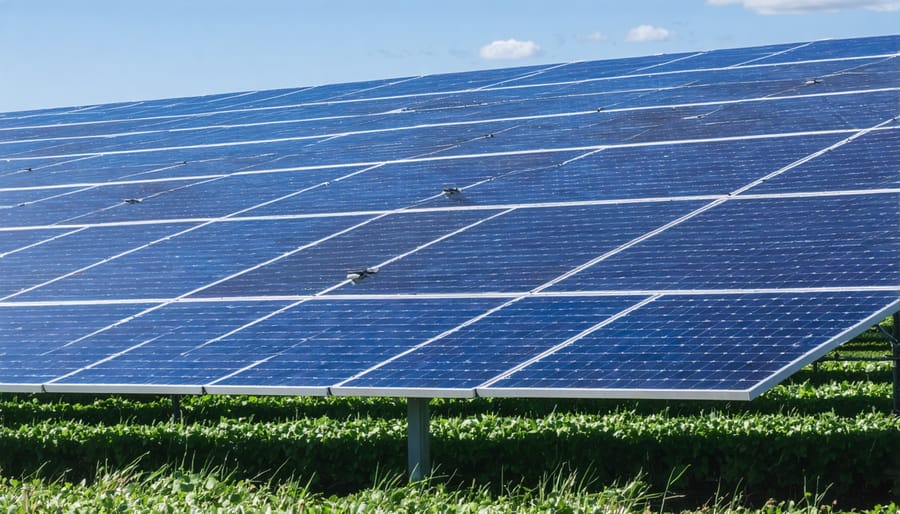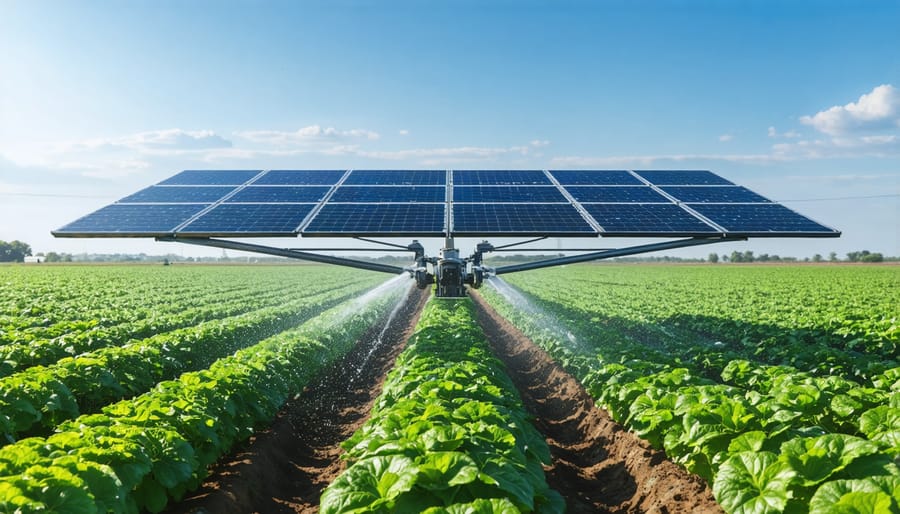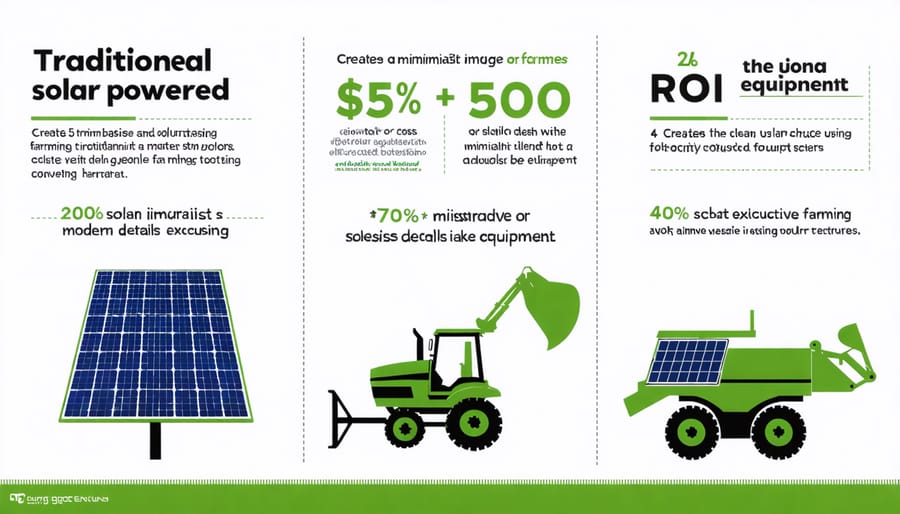Solar-Powered Farm Equipment Transforms European Agriculture

The revolution in solar-powered agriculture is transforming European farming operations, offering unprecedented opportunities to reduce operating costs while advancing sustainable practices. Modern solar-powered farming equipment, from autonomous irrigation systems to electric tractors, now matches or exceeds the performance of traditional machinery while slashing energy costs by up to 70%. For agricultural professionals navigating this technological shift, the integration of solar-powered equipment represents not just an environmental choice, but a strategic investment in operational resilience.
European farmers implementing solar solutions are discovering dual benefits: utilizing their land for both energy generation and crop production through innovative agrivoltaic systems. These advanced setups power essential farming operations while creating additional revenue streams through energy feed-in tariffs. With EU agricultural subsidies now prioritizing sustainable farming practices, the transition to solar-powered equipment has become not just technically feasible but financially advantageous.
The future of farming lies in harnessing solar energy to power everything from automated seeders to smart monitoring systems, creating a new paradigm of efficient, sustainable agriculture. This transformation is backed by robust European support systems, ensuring farmers can access both the technology and expertise needed to modernize their operations.
The Rise of Solar Technology in Modern Farming
Current State of Agricultural Energy Consumption
Agricultural operations traditionally rely heavily on fossil fuels, with European farms consuming approximately 950 million litres of diesel fuel annually. Modern farming equipment, from tractors to irrigation systems, typically accounts for 30-40% of a farm’s total operating costs, with energy expenses representing a significant portion of this expenditure.
The average European farm spends between €10,000 and €30,000 yearly on energy costs, depending on size and operational intensity. These costs have risen steadily over the past decade, impacting farm profitability and sustainability. Large-scale operations, particularly those with extensive machinery usage, face even higher energy bills, sometimes exceeding €50,000 annually.
Beyond the financial impact, traditional farming equipment contributes significantly to agricultural carbon emissions. The European agricultural sector currently generates about 10% of the EU’s total greenhouse gas emissions, with farm machinery being a major contributor. This environmental footprint, combined with increasing energy costs and sustainability requirements, has created a pressing need for alternative energy solutions in farming operations.

Solar Integration Benefits for Farmers
The transition to solar-powered farming equipment offers multiple compelling advantages for agricultural operations. Farmers can significantly reduce their operational costs through decreased fuel consumption and lower maintenance requirements, as solar systems typically have fewer moving parts than traditional equipment. This sustainable approach also provides greater energy independence, protecting farms against volatile fuel prices and supply chain disruptions.
Environmental benefits are equally substantial, with solar-powered equipment helping farms reduce their carbon footprint and align with EU environmental regulations. The quiet operation of solar equipment creates a better working environment and minimises disturbance to livestock. Additionally, many European countries offer attractive incentives and subsidies for agricultural businesses adopting renewable energy solutions.
Solar-powered systems demonstrate remarkable reliability in various weather conditions and can be integrated with existing farm infrastructure. Modern solar equipment often includes smart monitoring capabilities, allowing farmers to optimise their energy usage and equipment performance. The scalability of solar solutions means farmers can start with essential equipment and gradually expand their solar integration as needed, making the transition both practical and financially manageable.
Popular Solar-Powered Agricultural Equipment
Irrigation Systems
Modern solar-powered irrigation solutions have revolutionised water management in European agriculture. These systems combine solar panels, efficient pumping mechanisms, and smart controls to deliver precise water distribution across farmland while minimising energy costs and environmental impact.
The core component is the solar-powered water pump, which operates during daylight hours to fill storage tanks or directly feed irrigation networks. Advanced systems incorporate soil moisture sensors and weather monitoring stations to optimise water usage based on real-time conditions. This intelligent approach ensures crops receive exactly what they need, when they need it.
Most modern installations feature variable frequency drives (VFDs) that adjust pump speeds according to available solar power and irrigation requirements. This flexibility allows systems to maintain consistent performance even during varying sunlight conditions. For enhanced reliability, many European farmers opt for hybrid systems that can switch to grid power when necessary, ensuring uninterrupted irrigation during critical growing periods.
The technology scales effectively from small holdings to large agricultural operations, with options ranging from simple drip irrigation setups to comprehensive automated systems covering hundreds of hectares. Implementation costs have decreased significantly in recent years, while system efficiency continues to improve, making this technology increasingly accessible to European farmers seeking sustainable irrigation solutions.

Greenhouse Climate Control
Modern greenhouse climate control systems powered by solar energy represent a significant advancement in sustainable agriculture. These innovative systems utilize photovoltaic panels to power ventilation fans, temperature sensors, and automated shade screens, creating optimal growing conditions while minimizing energy costs.
The solar-powered climate management setup typically includes smart sensors that continuously monitor temperature, humidity, and CO2 levels. When environmental parameters exceed preset thresholds, the system automatically activates ventilation fans or adjusts shade screens to maintain ideal growing conditions. This precision control helps farmers achieve consistent crop quality throughout the year.
Energy storage solutions, such as advanced battery systems, ensure continuous operation during cloudy periods or nighttime hours. Many European greenhouse operations have reported energy cost reductions of up to 70% after implementing these solar-powered systems, while simultaneously improving crop yields through more precise climate management.
The integration of smart controls allows farmers to monitor and adjust settings remotely via smartphone applications, enabling quick responses to changing weather conditions. This technology is particularly valuable in regions with variable climate patterns, helping maintain stable growing environments regardless of external weather fluctuations.
For European growers, these systems often qualify for regional sustainability incentives, making the transition to solar-powered climate control both environmentally and economically advantageous.
Field Equipment and Tools
Modern solar-powered farming equipment has revolutionized field operations across Europe, offering sustainable alternatives to traditional machinery. Solar-powered irrigation systems lead the innovation, utilizing photovoltaic panels to pump water efficiently through fields and greenhouses. These systems can be programmed to deliver precise amounts of water based on soil moisture levels and weather conditions.
Solar tractors represent a significant advancement in field equipment, featuring roof-mounted panels that charge high-capacity batteries. While their working capacity currently ranges from 4-8 hours depending on sunlight conditions, they provide sufficient power for essential tasks like plowing, seeding, and light harvesting operations.
Innovative solar-powered tools include autonomous weeding robots that navigate crop rows independently, using minimal energy while effectively managing unwanted growth. Solar-powered sensors and monitoring systems provide real-time data about soil conditions, crop health, and weather patterns, enabling farmers to make informed decisions about resource allocation.
For smaller operations, portable solar-powered tools such as electric pruners, sprayers, and hand-held cultivators offer flexibility and efficiency. These tools typically feature removable battery packs that can be charged at solar charging stations installed around the farm.
Storage solutions, including solar-powered cold rooms and grain dryers, help maintain produce quality while reducing energy costs. These systems often incorporate smart technology to optimize energy usage based on ambient conditions and storage requirements, demonstrating the versatility of solar applications in modern farming.
Implementation and ROI
Initial Setup Considerations
Before implementing solar-powered farming equipment, careful planning and assessment of your agricultural operation is essential. Begin by conducting a comprehensive energy audit to determine your farm’s power requirements throughout the year, considering seasonal variations in equipment usage and daylight hours.
Site evaluation plays a crucial role in maximising solar efficiency. Assess available space for solar panel installation, considering both ground-mounted and roof-mounted options. The orientation and angle of panels significantly impact energy generation, with south-facing installations typically offering optimal performance in European locations.
Infrastructure requirements include robust mounting systems, weather-resistant wiring, and appropriate storage solutions. Modern battery systems are essential for ensuring consistent power supply during cloudy periods or nighttime operations. Consider installing smart monitoring systems to track energy production and consumption patterns.
Local regulations and permit requirements vary across European regions. Consult with agricultural solar specialists and local authorities to ensure compliance with building codes, agricultural land use regulations, and grid connection requirements. Many European countries offer specific guidelines for agricultural solar installations.
Financial planning should account for initial investment costs, available subsidies, and long-term maintenance requirements. Create a detailed implementation timeline that aligns with your farming calendar to minimize disruption to agricultural operations. Consider phased installation approaches to manage costs and assess system effectiveness gradually.
Remember to factor in future expansion possibilities and technological upgrades when designing your initial setup. This forward-thinking approach ensures your solar system can adapt to changing farm needs and emerging technologies.
Cost Analysis and Savings
The initial investment in solar-powered farming equipment typically ranges from €5,000 for small implements to €50,000 for comprehensive systems. However, the long-term financial benefits make this investment increasingly attractive for European farmers. Studies show that solar-powered equipment can reduce operational costs by 40-60% compared to traditional fuel-powered alternatives.
A typical return on investment period ranges from 4-7 years, depending on usage patterns and local solar conditions. Farmers implementing solar solutions report annual energy savings between €3,000 and €8,000 for medium-sized operations. These calculations factor in reduced fuel costs, lower maintenance requirements, and decreased equipment downtime.
Government incentives across European nations further enhance the financial appeal. Many countries offer grants covering up to 40% of initial costs, while others provide tax benefits and special depreciation allowances. For instance, French farmers can access the AGRISO program, offering subsidies up to €15,000 for solar equipment installation.
Understanding system efficiency is crucial for maximizing solar farm profitability. Modern monitoring systems help optimize energy usage, potentially increasing cost savings by an additional 15-20%. When combined with energy storage solutions, farms can achieve near-complete energy independence, protecting against rising electricity costs and market volatility.
Insurance companies increasingly offer preferential rates for solar-powered equipment, recognizing their lower risk profile and environmental benefits, leading to additional annual savings of 5-10% on insurance premiums.

European Support and Incentives
EU Agricultural Sustainability Programs
The European Union has established several robust programs to support the adoption of solar-powered farming equipment as part of its Green Deal initiative. Through the Common Agricultural Policy (CAP), farmers can access substantial funding for sustainable agriculture technologies, including solar-powered irrigation systems, electric tractors, and monitoring equipment.
Notable programs include the European Agricultural Fund for Rural Development (EAFRD), which offers grants covering up to 40% of investment costs for solar farming equipment. The LIFE programme specifically targets climate action and environmental projects, providing financial support for innovative solar applications in agriculture.
Member states have also developed complementary national schemes. For instance, France’s “Agriculture Innovation 2025” and Germany’s “Solar Innovation in Agriculture” programs offer additional funding options and technical assistance. These initiatives are supported by the European Innovation Partnership for Agricultural Productivity and Sustainability (EIP-AGRI), which facilitates knowledge sharing and practical implementation support.
Farmers can access these programs through their national agricultural ministries or regional authorities, with dedicated advisors helping navigate application processes and technical requirements. This comprehensive support structure has significantly accelerated the adoption of solar-powered farming solutions across the EU.
Regional Incentives
Across Europe, numerous incentive programs support the adoption of solar-powered farming equipment. In Germany, the Agrarsolaranlagen-Förderung program offers grants covering up to 40% of initial investment costs for agricultural solar installations. France’s ADEME initiative provides substantial funding for innovative farming technologies, including solar-powered irrigation systems and electric tractors.
The Netherlands leads with its SDE++ scheme, offering operational support for sustainable agricultural technologies over extended periods. In Spain, the Plan RENOVE specifically targets modernisation of agricultural machinery, with additional bonuses for solar-powered equipment purchases.
At the EU level, the Common Agricultural Policy (CAP) includes measures supporting green technology adoption, while the Next Generation EU fund allocates resources for sustainable farming initiatives. Many regional governments supplement these programs with local incentives, technical support, and tax benefits.
Farmers can typically combine multiple support schemes, maximizing their financial benefits. Local agricultural chambers and energy agencies provide guidance on available opportunities and application processes, ensuring farmers can make informed decisions about transitioning to solar-powered equipment.
The transformation of agricultural practices through solar-powered farming equipment represents a pivotal shift towards sustainable farming in Europe. As technology continues to advance and become more accessible, we’re witnessing increased adoption rates across both small-scale and industrial farming operations. The future outlook is particularly promising, with projections indicating that solar-powered agricultural equipment could reduce farming energy costs by up to 75% while significantly decreasing carbon emissions.
For European farmers considering this transition, the time to act is now. With current EU incentives and support programmes, implementing solar solutions has become more financially viable than ever before. The combination of reduced operational costs, environmental benefits, and increased energy independence makes a compelling case for investment in solar-powered farming equipment.
To successfully integrate these technologies, farmers should begin by conducting thorough energy assessments of their operations and identifying suitable equipment for solar conversion. Working with qualified solar energy consultants and agricultural technology specialists can ensure optimal system design and implementation.
The path to sustainable farming through solar power is clear, and the benefits are substantial. By embracing this technology today, European farmers can position themselves at the forefront of agricultural innovation while contributing to the continent’s renewable energy goals. Take the first step towards modernizing your farming operations by exploring available solar solutions and connecting with local agricultural solar specialists.
Leave a Reply